Favorite Articles of the Moment
Disclaimer
• Your life and health are your own responsibility.
• Your decisions to act (or not act) based on information or advice anyone provides you—including me—are your own responsibility.
Recent Articles
-
We Win! TIME Magazine Officially Recants (“Eat Butter…Don’t Blame Fat”), And Quotes Me
-
What Is Hunger, and Why Are We Hungry?
J. Stanton’s AHS 2012 Presentation, Including Slides
-
What Is Metabolic Flexibility, and Why Is It Important? J. Stanton’s AHS 2013 Presentation, Including Slides
-
Intermittent Fasting Matters (Sometimes): There Is No Such Thing As A “Calorie” To Your Body, Part VIII
-
Will You Go On A Diet, or Will You Change Your Life?
-
Carbohydrates Matter, At Least At The Low End (There Is No Such Thing As A “Calorie” To Your Body, Part VII)
-
Interview: J. Stanton on the LLVLC show with Jimmy Moore
-
Calorie Cage Match! Sugar (Sucrose) Vs. Protein And Honey (There Is No Such Thing As A “Calorie”, Part VI)
-
Book Review: “The Paleo Manifesto,” by John Durant
-
My AHS 2013 Bibliography Is Online (and, Why You Should Buy An Exercise Physiology Textbook)
-
Can You Really Count Calories? (Part V of “There Is No Such Thing As A Calorie”)
-
Protein Matters: Yet More Peer-Reviewed Evidence That There Is No Such Thing As A “Calorie” To Your Body (Part IV)
-
More Peer-Reviewed Evidence That There Is No Such Thing As A “Calorie” To Your Body
(Part III)
-
The Calorie Paradox: Did Four Rice Chex Make America Fat? (Part II of “There Is No Such Thing As A Calorie”)
-
Interview: J. Stanton on the “Everyday Paleo Life and Fitness” Podcast with Jason Seib
|
I’m back!
First, I would like to thank everyone who attended my presentation at the 2012 Ancestral Health Symposium, “What Is Hunger, and Why Are We Hungry?” The crowd was both high-powered and appreciative of my work, the Q&A session was constructive, and I’m looking forward to discussing the facts I presented in greater detail. However, I don’t think it’s productive to open that discussion until the video is available.
Meanwhile, as promised by my slides, the bibliography for “What Is Hunger, and Why Are We Hungry? – J. Stanton” is available at this link.
I can’t possibly enumerate everyone I met there—or even just those with whom I had the pleasure of speaking at length—but I must acknowledge a few people individually:
- Miki Ben-Dor, for his gracious acknowledgment of my contribution to his excellent presentation “Man the Fat Hunter”, and for being one of the few people with whom I can discuss evolutionary critiques of the agricultural and industrial socioeconomic system — subjects that I believe should be brought to greater prominence at AHS13.
- Seth Roberts, for leading off my Q&A session with a productive dialogue, and for the subsequent fascinating discussions.
- Melissa and Dallas Hartwig, for more great questions at the Q&A, their gracious acknowledgment of my contribution to “It Starts With Food”—and for the delicious dinner, which also allowed me some quality time with Anastasia Boulais and Jamie Scott.
- Stefani Ruper, John Durant, Todd Becker, and Mark Sisson, for reasons each knows.
- Ned Kock, for covering so much ground in the limited time we had available. We needed more.
- Paul Jaminet, for everything. I wish I could have joined you for drinks on Saturday, but the NPR interviewer kept me busy for well over an hour!
- The AHS team on-site—especially Aaron Blaisdell, Carlos Andres Toro, Katherine Morrison, and Beth Mazur.
I’ll be catching up on my backlog of unanswered comments and emails over the next few days.
Meanwhile, the wildflowers have been disappointing this year, due to a dry spring (unlike last year, which was spectacular)…but the riding has been excellent due to a few minor but welcome rain showers.
Click here to watch in HD (recommended).
Chase-cam by my friend Jeff.
Live in freedom, live in beauty.
JS
While city dwellers were rioting in the UK, the wildflowers were rioting in the Sierras. Though it arrived in late August, over a month late, we had a truly astounding wildflower season this summer.
Wildflower Riot!
 In the High Sierra, there's not much summer in which to bloom...and what with the late snows, everything went off all at once.  Lupines! Most alpine flowers have no scent, but lupines smell wonderful.  Mule's ears. You'll find entire hillsides covered with these. Yes, mountain bikers stop to smell, photograph, and otherwise appreciate the flowers. Riding allows people with families to support, and who don’t have time for multi-day backpacking trips, to see backcountry they could never see otherwise…and there are a lot of people with bad knees who simply can’t hike long distances anymore, especially with a heavy pack. Someday you’ll probably be one of them.
Please consider that the next time you’re advocating for wilderness designation, which singles out bicycles for removal while permitting boats, ski touring gear, climbing gear, and commercial horsepacking operations…and often grandfathers in everything from airstrips to snowmobiles to jet skis to operating mines. (Here’s a startling list of wilderness ‘exceptions’.)
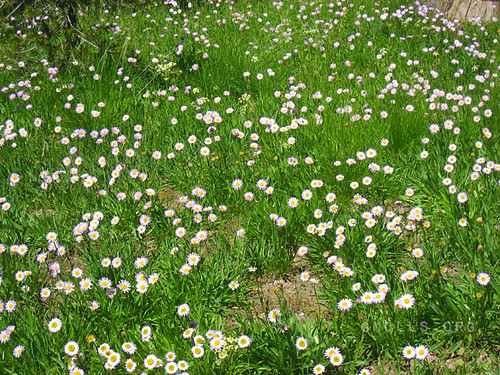 Daisies...or something that looks like a daisy. (I'm not a botanist.) Yes, they're a bit purplish. 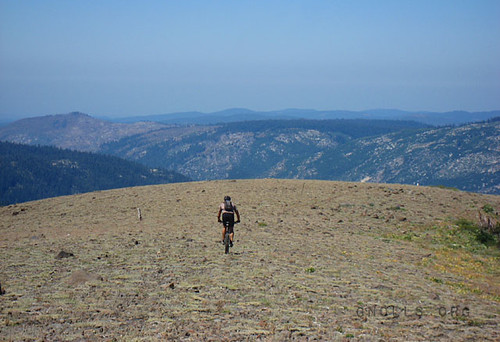 Riding on the alpine tundra and into the void. 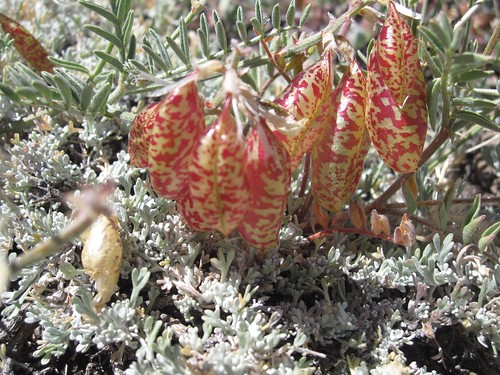 Apparently the aliens have a foothold up here. 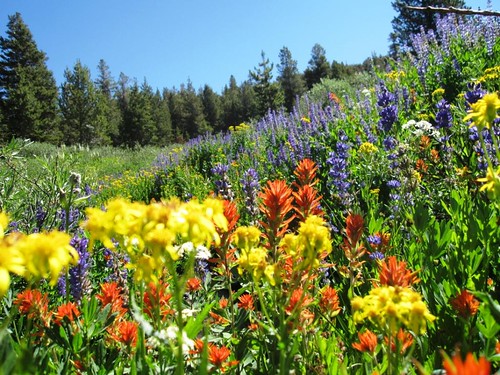 If I were a bee, this would be heaven. It was impossible to be more than eight inches from a flower. (Some photos were taken by my friend Jeff.)
A Few Observations About The State Of The Paleo Community
- The first problem with already knowing everything is that we can’t learn anything.
- The second problem is that if new information finally sneaks around or smashes through our protective shield of omniscience, it’s difficult to explain why today’s definitive, prescriptive advice differs so radically from last year’s—and, more importantly, why this year’s won’t differ radically from next year’s.
- Phrases such as “I don’t know” and “That’s interesting, tell me more,” do not diminish my stature or reputation.
- If you wonder whether this applies to you, it probably doesn’t…and those of us who need to hear it the most won’t think it could ever possibly apply.
- Not knowing everything doesn’t mean we throw up our hands and say “Whatever makes you feel good, man.” We know quite a bit about nutrient (and anti-nutrient) content of foods, and about how they’re metabolized. Just because some people can tolerate suboptimal nutrition doesn’t mean anyone should.
- In my opinion, the best argument for keeping starch consumption to the lowest level that allows you to maintain your health and level of physical activity is that concentrated starch and sugar sources are nutrient-poor (or, in the case of most grains, actively disruptive) compared to animal foods. If you want me to eat lots more starch calories, “well, it won’t kill you, IF your glucose regulation is good” isn’t a sufficient argument to displace nutrient-rich animal foods like egg yolks from my diet.
- This is doubly important for people trying to lose weight: we might be ingesting fewer calories, but that doesn’t mean we need any less choline, B vitamins, magnesium, or anything else.
- That being said, I eat a substantial quantity of starch—because I’m regularly out there burning glycogen on a bicycle, on skis, or on foot. Up to perhaps 20% of calories is fine for the metabolically functional…beyond that, we’ve got to EARN those potatoes.
- It’s easy to put up a wall of citations—but if a hypothesis contradicts observed reality, it’s best to take a step back. People didn’t suddenly become lazy and gluttonous starting in 1978, and food didn’t suddenly become tasty in 1978 either. (Graph here.) And while I’m fond of pointing out that the US government first tried to change our diet in 1977, I don’t believe that we became obese purely at our government’s command.
- A final concept for our evaluation and discussion: a “set point” is just a homeostasis we don’t understand yet. Thoughts?
Most importantly, I believe the paleo community is stronger for these controversies. Natural selection means that some animals survive and some die—and so it is online, in the world of ideas. The survivors will be those who are willing to do the careful, patient, unglamorous work of reading the scientific literature, summarizing and communicating it in an understandable way, and producing both testable hypotheses and practical advice from it. And while there is much solid work being done, I must give special mention to Paul Jaminet at Perfect Health Diet for his recent work tying together thyroid, diet, and LDL (make sure to follow the links within), and to Peter Dobromylskyj at Hyperlipid (and his commenters, particularly Stan the Heretic) for his recent work on mitochondrial dysfunction. This sort of collaborative investigation is what the Internet is for…
…and it can only be performed by those of us who don’t already know all the answers.
Live in freedom, live in beauty.
JS
As I mentioned at the end of last week’s article, I’m taking a week off to enjoy the summer holidays—and the ridiculous snowpack here in the Sierras, which has allowed me three days of excellent skiing in July.
I’ll be back on my regular weekly schedule next week, but in the meantime, it is important to not die.
How Not To Die While Slow-Roasting A Pork Shoulder (Also Known As A “Pork Butt”)
Earlier this year, I decided to slow-roast a pork butt overnight in the oven. After it had been in for several hours, and just as I was falling asleep, my carbon monoxide alarm went off.
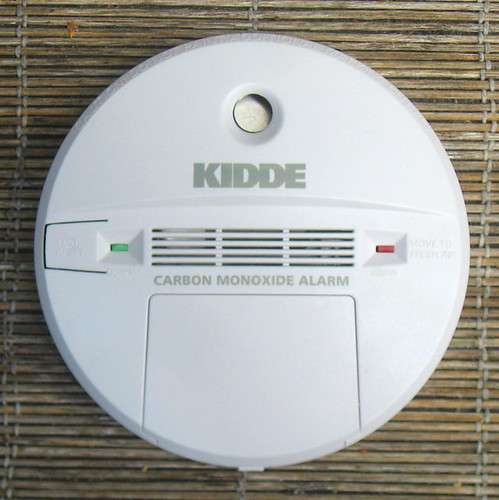 This carbon monoxide detector saved my life. Winters are cold where I live. In order to be energy-efficient, I weatherstrip my doors and seal the drafts under them. And since my living area has good solar gain in the daytime, the forced-air heater often won’t come on until very late at night.
Apparently, in a well-insulated home or apartment, a gas oven can produce dangerous amounts of carbon monoxide in just a few hours. And since I was just getting ready to fall asleep, it is very likely that without a working carbon monoxide alarm just outside my bedroom, I would not have awakened the next morning.
At this point, I feel it appropriate to thank my mother (who insisted I have one) and the Kidde corporation (whose product still functioned correctly, even past the end of its advertised 5-year service life) for saving my life.
And because being alive is important, I strongly recommend that everyone own a carbon monoxide detector.
Yes, you’ll be irritated when it gives you that “low battery” chirp every nine months or so, and you’ll be annoyed that the batteries don’t last nearly as long as those in your smoke detectors.
You’ll also be alive.
You should be able to find carbon monoxide alarms at your local hardware store. However, if you’d like to support gnolls.org, you can buy them through the following Amazon links. (Plus, in my experience, Amazon is cheaper.)
Available models have changed somewhat since I bought mine: the most recent “Nighthawk” models come with a 7-year guarantee and are UL listed. And as a bonus, they come with batteries!
Here’s the basic unit: Kidde KN-COB-B-LS Carbon Monoxide Alarm. $23 as of this writing.
And here’s the next model up, which has a digital display that shows the actual CO level: Kidde KN-COPP-B-LS Carbon Monoxide Alarm. $35 as of this writing.
(Note that natural gas or propane heater malfunctions can also result in carbon monoxide poisoning, even if you have electric appliances. And a wood or pellet stove can get you if the flue clogs or the vents leak.)
How Not To Die While Riding A Mountain Bike
During the early season, there are often trees down on the trail—especially after spring storms.
Just a few days ago, I was riding a trail for the first time this year. In the middle of a fast and overgrown section with poor sight lines, I suddenly encountered a small fallen tree, whose sharp, splintered end was aimed directly at my chest.
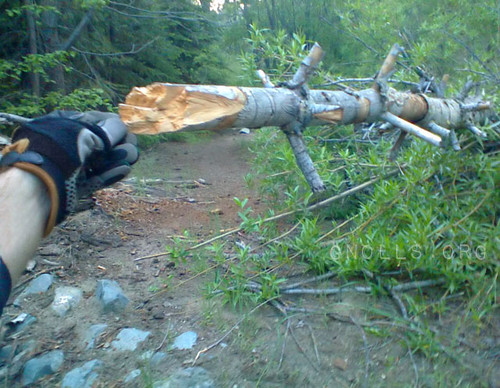 If I had been going fractionally faster, or been paying less attention, this would have had my corpse stuck to the end of it. I don’t think I’ve ever stopped a bicycle quite that fast—and the sharp end still ripped my glove and cut my fingers as it pushed past, stopping about four inches from my heart.
The moral of this story: Don’t override your line of sight, even on a familiar trail. And always keep your braking system properly adjusted and maintained. Someday you may need every last Newton of force it can provide.
Live in freedom, live in beauty.
JS
|
“Funny, provocative, entertaining, fun, insightful.”
“Compare it to the great works of anthropologists Jane Goodall and Jared Diamond to see its true importance.”
“Like an epiphany from a deep meditative experience.”
“An easy and fun read...difficult to put down...This book will make you think, question, think more, and question again.”
“One of the most joyous books ever...So full of energy, vigor, and fun writing that I was completely lost in the entertainment of it all.”
“The short review is this - Just read it.”
Still not convinced?
Read the first 20 pages,
or more glowing reviews.
Support gnolls.org by making your Amazon.com purchases through this affiliate link:

It costs you nothing, and I get a small spiff. Thanks! -JS
.
 Subscribe to Posts Subscribe to Posts
|
Gnolls In Your Inbox!
Sign up for the sporadic yet informative gnolls.org newsletter. Since I don't update every day, this is a great way to keep abreast of important content. (Your email will not be sold or shared.)
IMPORTANT! If you do not receive a confirmation email, check your spam folder.
|










